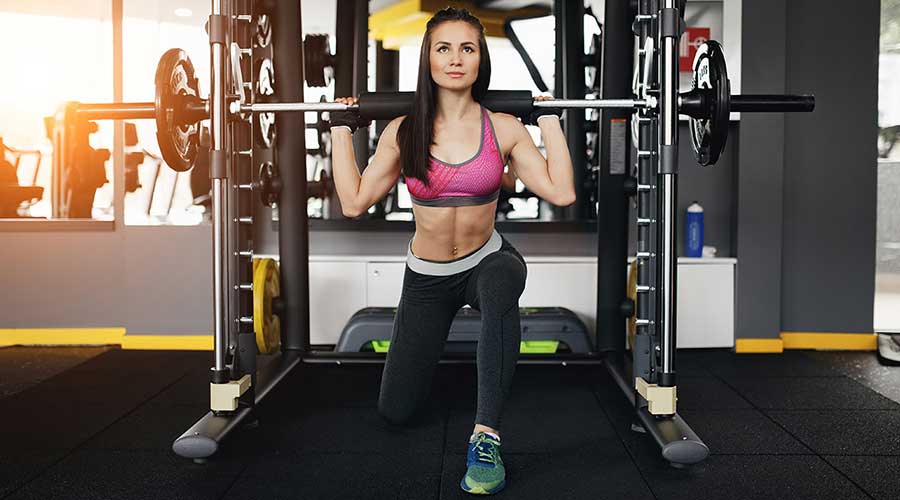Fit for Two: Exercise Guidelines During Pregnancy
- 13 Apr - 19 Apr, 2024
Before social distancing orders were put into place, access to a barbell, squat rack, weight plates on weight plates on weight plates was a short drive to the gym away. But nearly half a year into the coronavirus pandemic, and most studios and gyms are still closed. Sigh.
So, you may be noodling on ways to finagle some sort of squat stand into your garage, basement, or living room. We’re with you. Just last night, after measuring out the spare space in our bedroom-turned-office, we were furiously googling "homemade squat rack" and "cheap squat rack." Truthfully, the search results were pretty helpful on how to build a homemade squat rack, and they had some helpful ideas.

Take two step ladders, that are about five feet high, then plop a barbell on top. Easy!
When choosing ladders, the two important factors to keep in mind are height and load. You want the barbell to be at a height that you can dip underneath the bar, and lift it when you stand up (without getting on your tip-toes). Typically, optimal bar height will be around six to 12 inches shorter than the height of your head. So, if you're 5'8", you're going to want two ladders that are 5ish feet tall. But if you're closer to 5', a ladder closer to 4' is a better pick.
Before you buy, be sure to peak at the ladder's weight capacity. Most ladders can hold 300 pounds, so unless you're squatting huge weights, there should be no issue. But for the sake of safety, take a peek, okay?
Oh, and because the barbell will roll off the ladder unless you're holding it, we recommend securing rubber corner-guards to the corners of the top platform.
Looking for something you can easily assemble and dismantle? Grab some milk crates – because when they're not trucking milk, they can be used to hold your barbell. You can literally just make two stacks of three or four milk crates and sit a barbell between them.
While he says these are pretty darn sturdy, you can zip-tie the crates in each stack together for extra reassurance. If you put the open side of the crates pointing up, the weight plates on the barbell should be able to nestle right into the opening. If, for whatever reason, you need to flip them over, to keep the bar from rolling off the top of the crates, try using those aforementioned rubber stoppers.
If you've got access to a boat-load of tires, stack them! You might be able to go to a junkyard or your town's tire shop to get old tires for free. Truthfully though, if not, this isn't your most cost-effective option.
HGTV-ing your own squat rack is no small feat. So, if you need a refresher on why building one is worth the work, here's a reminder!
For starters, you can crank out weighted barbell front and back squats (both of which are full-body movements) with the help of a squat rack. When done with proper form, barbell front and back squats can help you build muscle in your quads, hamstrings, glutes, calves, core, and more. And building muscles has perks like increased muscle mass, reduced body fat, boosted metabolism, and more.
Plus, squats aren't the only move you can do with a squat stand. Squat racks allow you to easily do other strength movements like barbell lunges, Bulgarian split squats, shoulder press, and more.
And if you don't have a squat rack, don't worry, you've still got options!
Not good with a hammer? Can't find a barbell and plates to go with your squat rack? Fear not. It's entirely possible to weight your squats – and do movements like the push-press, bench-press, or weighted lunge – without a rack or barbell.
If you already have other weights such as dumbbells, kettlebells, or sandbags on hand, holding the weight in a goblet position. Doing so will really fire up your glutes and core. If the weights you have are lighter than your usual squat weight, implementing a three to five second hold at the bottom of each squat to increase the time under tension and thus boost strength gains. You can also add resistance bands to already-weighted moves to fake the feeling of heavier weights.
If not, it's time to see your house through the lens of a lifter. Cat litter, mulch, five-gallon water-bottles, old milk jugs, and bags of flour can all be used to weight movements. You can even just throw a bunch of dirt or mud into a garbage bag, tie it up, and use it as a sandbag.
COMMENTS